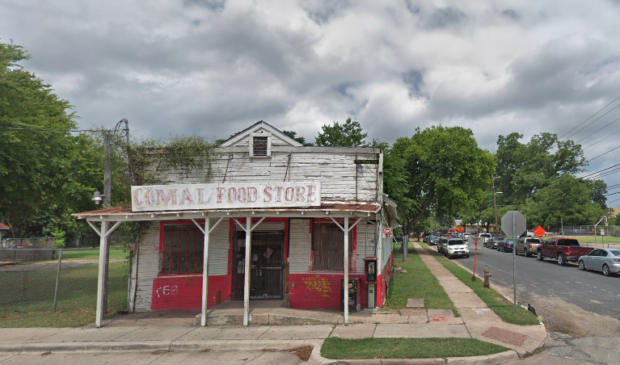Planning Commission unmoved to recommend preservation for East Austin grocery store
Friday, August 16, 2019 by
Jessi Devenyns After a unanimous recommendation from the Historic Landmark Commission to preserve the 1922-era corner grocery at 220 Comal St., the momentum behind preserving the East Austin structure slowed at the Planning Commission.
“I’m getting the sense that the owner can preserve the building better without historic designation,” Commissioner Carmen Llanes-Pulido said at the Aug. 13 meeting of the Planning Commission.
Other commissioners favored a historic zoning designation to preserve the building. Commissioner Don Leighton-Burwell noted, “The valuation (of the property) is $1.4 million. That’s a pretty big incentive from my perspective to tear this building down.”
With split views on the matter, the commission failed to recommend historic zoning for the building with a 6-3 vote.
The building is an early-20th-century neighborhood grocery store built in a simple rectangular footprint style by Dutch immigrants. It was continuously run as a grocery store until the 1970s with various long-term owners, including a Chinese American grocery merchant in the 1930s and ’40s. According to a report by the Historic Preservation Office, this type of building used to be commonplace in East Austin, but is now a rarity.
Although the owner of the property, Rosa Santis, said it was her intention to renovate the building in the same footprint that now exists, Historic Preservation Officer Steve Sadowsky told commissioners that verbal assurances do not have any guarantees. According to him, historic zoning is the only way to “put teeth” into the push to preserve the facade, which he said does not need to be demolished to address the code violations.
As the building currently stands, restorations to the facade are necessary. The structure was cited for code compliance issues, prompting the owners to file for a partial demolition permit to make repairs.
“We really need to resolve the status of the structure,” said attorney Micah King, who was representing the applicant. However, he said that remedying the current state of the structure does not include making it historic. “The math doesn’t work for the property owner. It is too cost prohibitive,” he said.
Commissioners pointed out that many of the fixes for code violations, including foundation repair, would be necessary with or without a historic “H” attached to the property’s zoning. The condition of the siding, which presented a particular problem to the applicant, also did not seem to concern commissioners.
“If the issue is the siding, you could pick the siding you want out of a catalog … you pick it up and you put it on,” explained Commissioner James Shieh, who said he had worked on multiple historic home restoration projects. He noted that while siding that is appropriate for a historic structure will cost more, it is not cost prohibitive when compared to foundation repair.
King told the commissioners that beyond being cost prohibitive, there has been insufficient evidence to prove how the grocery store has contributed to the community over the years.
Community members attending the meeting spoke to the importance of the structure for the neighborhood.
“That is one of the last standing buildings that these people can actually look at and remember what their neighborhood was about,” said Mike Borrero, a neighborhood resident and the owner of Mike’s Formal Wear.
“It may not have been owned by Mexican descent, but it does bring community value to our neighborhood,” said Bertha Delgado, the vice chair of the Community Development Commission.
Shieh said that the mixed history of Asian American and Dutch immigrant owners associated with the building is what makes it such a novel site and worthy of preservation.
If the building does not gain a historic designation, there is no obligation to retain the structure, which sits on a half-acre lot. The grocery store occupies only a small corner with street-facing frontage. City staff members recommended historic zoning to additionally encompass a 10- to 25-foot buffer to protect the integrity of the building.
“It actually has the highest level of integrity of any building of this type in the city,” said Sadowsky.
At the vote, commissioners Llanes-Pulido, Fayez Kazi and Conor Kenny abstained and commissioners Awais Azhar, Patrick Howard, Patricia Seeger, and Robert Schneider were absent. The case will now go to Council on Sept. 19 with no recommendation from the Planning Commission.
Photo courtesy of Google Maps.
The Austin Monitor’s work is made possible by donations from the community. Though our reporting covers donors from time to time, we are careful to keep business and editorial efforts separate while maintaining transparency. A complete list of donors is available here, and our code of ethics is explained here.
You're a community leader
And we’re honored you look to us for serious, in-depth news. You know a strong community needs local and dedicated watchdog reporting. We’re here for you and that won’t change. Now will you take the powerful next step and support our nonprofit news organization?






